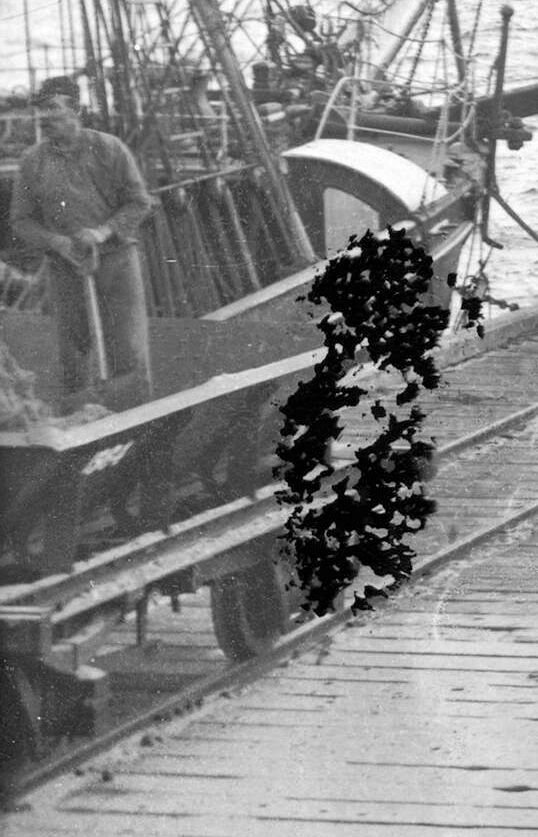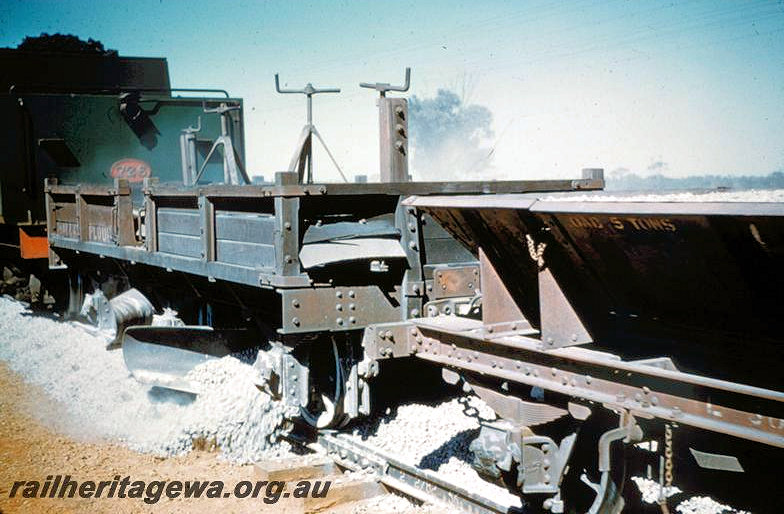| Class L Ballast Hopper (class U before 1900, then class K until 1903) |
|
The L class ballast hoppers have one of the most complicated histories of any type of WAGR wagon despite only involving about 200 wagons. It is not helped by the fact that several distinctly different types are lumped together in the same class. Whilst this may not have mattered to the traffic department it does make life difficult (or fascinating depending upon how you look at it) for the historian. What follows has probably got errors in it but without more photographic evidence is the best that I can manage at present. |
A blow up from State Library of WA photo 007128d showing an early all metal L class wagon. Sadly the number is unreadable. |
|
It all started very simply. A batch of twenty 5 ton hopper wagons were built in 1894 and numbered 995 to 1014. Originally they were class U. Another batch, this time of 40 wagons numbered 1355 - 1394 entered service in 1895. A single larger 6 ton hopper numbered 2066 was built in 1898. This is where the complexity starts. The 1903 diagrams show 4 different ballast hopper diagrams. One of these is the six ton wagon easily identified as 2066. The WAGR outline diagram for L2066 is shown below.
The other three diagrams are: 1. A wooden bodied hopper with dropside doors on a NZR type composite underframe. (L1)
2. A steel bodied hopper with dropside doors on a steel underframe. (L2)
3. A steel bodied hopper on a steel underframe without side doors. (L3)
I believe that the 995-1014 batch were probably wooden bodied wagons (based I think on a NZR design). |
|
To add to this already difficult situation ballast hoppers were both sold out of WAGR service and bought back from contractors in these early years. It is known that 30 hopper wagons were sold to Smith & Timms in November 1897. Thus by the end of June 1899 the WAGR stock of ballast hoppers was down to 15 wagons (from 60!) numbered 999, 1008, 1010, 1011, 1013, 1359, 1361, 1362, 1364, 1368, 1370, 1372, 1373, 1377 and 1394. Giving (I think) at least 5 wooden bodied wagons and maybe 10 steel bodied ones. The wagons that were disposed of almost certainly went to railway construction contractors and the Public Works Department (PWD). A new number (1314) is also on the 1900 list and the numbers 1355-1358, 1360, 1363, 1365-1367, 1369, 1371, 1374 -1376, 1378 were again on the departmental list giving a solid block of numbers from 1355-1378. It is unclear whether these were the original wagons regaining their old WAGR numbers or not. 1369 at least was one of the steel type L3 without side doors as shown in the WAGR official view from the RHWA collection below. In 1900 the WAGR bought twenty ballast hoppers from the contractors Smith & Timms. These were given new numbers at the end of the list:
Why were they numbered in two groups? There are at least two possibilities i.e., they were acquired in two batches or they were of two distinct types. Interestingly L4883 and L4884 are listed as having South Australian type underframes. This suggest that more than two types were probably involved. From 1900 to 1903 the ballast hoppers were classified K along with the dropside ballast wagons (basically H class wagons with bottom doors). Thankfully this extra element of confusion didn't last long and from 1903 they were class L. Numbers 1011 and 4887 had gone by 1909 and at this point the stock consisted of 24 wooden bodied hoppers on composite underframes (up from 19 in 1908, 21 in 1902 and 20 in 1900), 8 all steel hoppers with dropsides (down from 9 in 1908, 10 in 1901 and 20 in 1900) and 17 all steel hoppers with fixed sides (down from 21 in 1900) according to the WAGR diagrams. The full list of L class wagons in 1909 when the record cards start was:
It is more or less impossible to distinguish which of these wagons was of which type from this muddle without a lot more information. |
|
On completion of the Port Hedland line in 1912 the WAGR purchased 12 more ballast hoppers from Smith and Timms. Again it is likely that these were ex WAGR wagons but could include ex SAR wagons. They got new numbers at the end of the list and became L8824-8835. WAGR records suggest that 8826, 8827 and 8829 were wooden bodied wagons but these three wagons appear in a State library of WA photo (28010P) where they definitely don't have side drop doors but might still have planked sides (the photo is slightly fuzzy and it is difficult to be sure). They definitely don't have the NZR type underframe either. These wagons never left the Port Hedland line again. In 1919 L8832 was converted to a J class tanker at Port Hedland and in 1932 the remaining Port Hedland wagons were converted to HA class dropside wagons. A new type of L class hopper appeared in 1914. Ten brand new wagons were built at Midland Workshops and numbered L10049 - 10058. These had a heavy wooden underframe with similar components to the GC class and a steel hopper. They were 16'-0" long over headstocks. The steel hopper with dropside doors and 4 heavy stanchions at either end. Another group of ballast hoppers was taken over from the PWD in 1918. These became L10059-10086 and I believe that they were of the same type as the 1914 batch (but they could be another mixed group of wagons). |
|
In 1931 the WAGR took over most of the PWDs remaining rolling stock and a further 62 hoppers entered the WAGR stock. They were given random numbers in the WAGR list. They can be divided into three groups. The first group listed as having wooden GC type underframes were PWD numbers :
Which became L class numbers
Note that some of these ex PWD wagons re-used numbers in the original 1895 sequence. These appear to be of the 1914 type (L1113 pictured below in a WAGR official photo - ARHS(WA) archives). |

|
A further five wagons are listed as having WAGR "steel" underframes (possibly actually NZR type composite underframes) and wooden hoppers. These were PWD numbers:
which became L class numbers:
These were likely to have been WAGR wagons. Finally there were ten wagons with South Australian type underframes. The PWD numbers of these were:
which became L class numbers:
It is not clear what underframe PWD 70 later L4138 had, but it was probably a wooden one as it was rebuilt in 1931. As if this wasn't complicated enough a rebuilding programme was started in the 1930s. Nominally this was about lengthening the wheelbase of the wagons to 8'-9" but I suspect the end result was wagons with completely new underframes (or possibly completely new wagons). The wagons involved in this process were rebuilt as follows: |
| 1930 | 5102 |
| 1931 | 4138, 5098 |
| 1932 | 1359, 1373, 1378, 2842, 4881, 4882, 4888, 4890, 5099 |
| 1933 | 1008, 1314, 1375, 1377, 3978, 4039, 4171, 4177, 4181, 4884, 5095, 10062, 10085 |
| 1934 | 4883, 5097 |
| 1936 | 1374 |
| 1937 | 4889, 10060 |
| 1939 | 1360, 4885, 5100 |
|
This process seems to have taken a particularly heavy toll of the wagons with the South Australian type underframes with eight out of the thirteen being rebuilt. Some may not even have run in WAGR service before being rebuilt. None of the PWD wagons with wooden underframes were involved suggesting that these may have been relatively new wagons at the time. It is distinctly possible that other unrecorded rebuildings also took place. The rebuilds are shown in the following tables in red. A group of twenty wagons (614, 619, 647, 659, 702, 730, 883, 1114, 1382, 1463, 2317, 2467, 2720, 2975, 3033, 10050, 10051, 10058) were converted to carry bulk wheat in 1945 by the addition of 5 wooden planks to the top of the hopper and reclassified LW. One wagon was written off as an LW (2317) but all of the rest returned to class L in 1950 once more suitable wagons were available for the wheat traffic. The table below sums up the disposal of the class. |
| 1899 | 995, 996, 997, 998, 1000, 1001, 1002, 1003, 1004, 1005, 1006, 1007, 1009, 1012, 1014, 1358, 1379, 1380, 1381, 1382, 1383, 1384, 1385, 1386, 1387, 1388, 1389, 1390, 1391, 1392, 1393 sold? |
| before 1909 | 1011, 4887 sold? |
| 1919 | 8832 to J |
| 1932 | 8824, 8825, 8826, 8827, 8828, 8829, 8830, 8831, 8833, 8834, 8835 converted to HA |
| 1934 | 2066 written off. To JETTY 307 in 1935 |
| 1944 |
1394, 5101 written off 1314, 1370 to JETTY 355, 437 |
| 1946 | 1376 written off |
| 1952 | 3754 written off |
| 1957 | 1372, 1378, 4882, 10056, 10072 written off |
| 1958 | 1368, 1377, 4167 written off |
| 1959 | 4090, 4140, 5096, 5100, 10086 written off |
| 1961 | 646, 647, 1359, 2842, 3879, 5095, 10063, 10084 written off |
| 1962 |
614, 1113, 1162, 1893, 3817, 3841, 3978, 10050, 10076 written off 730 to JETTY 351 |
| 1963 | 1013, 1365, 1367, 3889, 4166, 4886, 4888, 10075 written off |
| 1964 | 1094, 1114, 5102, 10059 written off |
| 1965 | 619, 1020, 1374, 3033, 4891, 10073, 10085 written off |
| 1967 | 999, 1356, 1361, 1363, 1373, 3180, 3877, 4039, 4157, 4181, 4186, 4890, 5103, 10055, 10074 written off |
| 1968 | 659, 1139, 1252, 4885, 10051, 10062 written off |
| 1970 | 616, 786, 1081, 1905, 2975, 10054, 10057, 10083 written off |
| 1971 | 933, 1355, 2467, 2557, 5098 written off |
| 1972 | 623, 698, 700, 702, 714, 716, 722, 724, 734, 773, 883, 931, 1008, 1010, 1149, 1166, 1246, 1357, 1360, 1362, 1364, 1366, 1369, 1371, 1375, 1382, 1463, 1985, 2288, 2452, 2510, 2583, 2597, 2671, 2693, 2720, 2989, 3074, 3152, 3759, 3774, 3838, 3878, 4138, 4171, 4177, 4530, 4881, 4883, 4884, 4889, 5097, 5099, 10049, 10052, 10053, 10058, 10060, 10061 written off |
|
Note that JETTY 350 was an ex L wagon missing at the 1963 stocktake. It is recorded as L623 but L623 was not written off until 1972!
The WAGR official image image at right from the RH WA collection shows either L3033 or L3074 immediately behind an LX class ballast plough. This wagon is one of the L2 type as defined at the top of this page |






